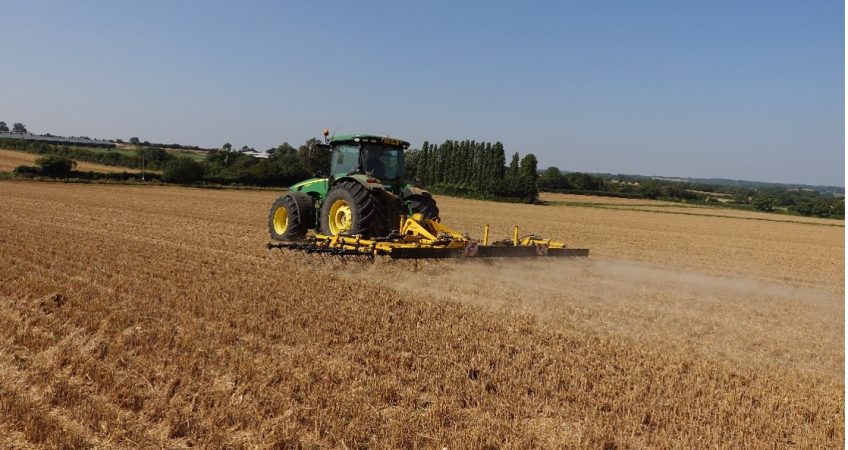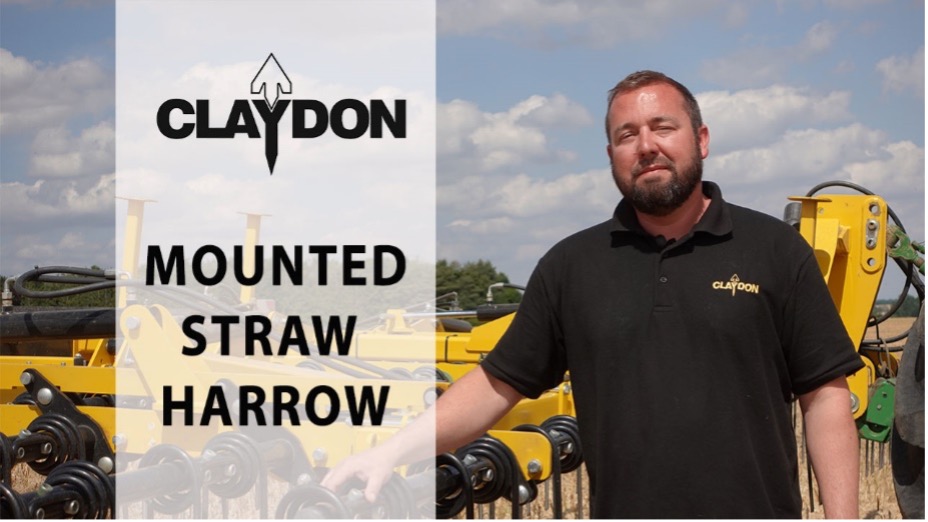
It’s July on the Claydon farm and the oilseed rape crop has just been harvested. Chasing the CLAAS Lexion 600 Terra Trac combine harvester out of the field is the Claydon Straw Harrow. It doesn’t just harrow straw; this versatile stubble management tool has multiple uses.
This 9m mounted tool is the latest edition to the Claydon range, which comprises a 3m and 7.5m mounted version, and a 12m and 15m trailed model. It is the 9m model which is being used on the Claydon arable farm in West Suffolk this season. All crops are seeded with a Claydon direct strip till drill so you can see on the field both the oilseed rape stubbles from this year’s crop and also the winter wheat stubbles from the previous crop.
This year’s oilseed rape crop has yielded well, despite the very dry growing season. There is also quite a lot of crop residue on top of the soil which has been chopped by the combine harvester. This debris protects and insulates the soil. Our versatile stubble management tool is used to spread and dissipate crop residues. It shakes up and breaks them up, creating an even mulch covering across the entire field. This provides an ideal environment for the next crop to be drilled into in the autumn.
The farm’s 9m stubble management tool has 16mm flexible, wrap-around steel spring tines (14mm tines are also available). The flexibility of the tines allows this straw rake to turn on the headlands without having to be lifted. Keeping the harrow engaged and “in work” on the headlands means that you don’t drag and dump heaps of straw and crop residues at the ends of the field. These heaps won’t break down very easily and crops drilled into them are likely to have uneven emergence. Heaps of crop residue are also an attractive home for slugs.

Straw harrowing begins as soon as the combine harvester has left the field. The difference between the harrowed and unharrowed soil is clear to see, even during a prolonged dry spell and high summer temperatures. The unharrowed soil is hard and baked with shrinkage cracks, whereas the harrowed soil has a crumbly, fine tilth and the crop residue has been broken up into small pieces. Oilseed rape seeds that have been shaken from their pods onto the ground will be quick to germinate in humid soils after rain or heavy dew.
When these volunteer seedlings have reached the single-leaf cotyledon stage, another pass of the straw harrow rakes them out. This mechanical weed control reduces the chemical burden. It also encourages a good flush of weed growth as the volunteer seeds are not stuck within their pods and husks – they are broken up and shaken to the ground.
The layer of straw on the surface of the soil protects the soil and locks in moisture, so weeds and volunteers grow when we want them to so we can rake them out and deal with them when we want. The harrow prepares the soil perfectly and creates a stale seedbed for the next crop to be drilled into.
This tool is also a very effective method of slug control. The vibrating action of the spring tine breaks up slug populations and turns over straw to expose slug eggs to sunlight. The ultraviolet rays desiccate slug eggs, reducing slug numbers.
Travelling at speeds of 15-25 km/h and using 2 litres of fuel per hectare, the Claydon Straw Harrow is a very fast and cost-effective stubble management tool. The cost and time savings are substantial, compared to other cultivation operations. By controlling weeds and slugs mechanically instead of by using chemicals, the straw rake also has its place in organic farming.

To see the Straw Harrow in action, visit here, or the product page, and get in touch with us today!


